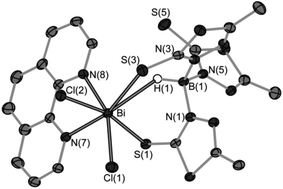Synthesis, structural and photo-physical studies of bismuth(iii) complexes with Janus scorpionate and co-ligands†
Abstract
Some novel complexes of bismuth(III) with the Janus scorpionate ligand [HB(mtdaMe)3]− (mtdaMe = 2-mercapto-5-methyl-1,3,4-thiadiazolyl) were synthesised. Na[HB(mtdaMe)3] (1) was reacted with BiX3 (X = Cl, I, NO3) in the molar ratio 2 : 1 to afford the bismuth complexes {HB(mtdaMe)3}2BiCl (3), Na[{HB(mtdaMe)3}2BiI2] (4) and [{HB(mtdaMe)3}2Bi(NO3)]n (5). Two mixed complexes {HB(mtdaMe)3}Bi(phen)Cl2 (6) and {HB(mtdaMe)3}Bi(bipy)Cl2 (7) were obtained using Janus scorpionate as the primary ligand in the presence of 1,10-phenanthroline and 2,2′-bipyridyl, respectively, as co-ligands in the 1 : 1 ratio. The obtained complexes were characterised by 1H, 13C and diffusion NMR (DOSY), elemental analyses and mass spectrometry. Structures of the compounds NBu4[HB(mtdaMe)3] (2), 3, 4, 5, 6 and 7 were determined by single crystal X-ray diffraction. The molecular dynamic process in complex 3 was also studied by variable temperature NMR measurements. All bismuth complexes, except for the polymeric 5, are monomeric. Complexes 6 and 7 exhibit (B)H⋯Bi distances of 2.76(3) and 2.71(2) Å length, respectively. Compounds 2, 6 and 7 were screened for their luminescence activity. At 77 K in ethanol solution, complexes 6 and 7 exhibit phosphorescence from ligand-to-ligand charge transfer (LLCT) and the ligand-centred (LC) excited state, respectively.


 Please wait while we load your content...
Please wait while we load your content...